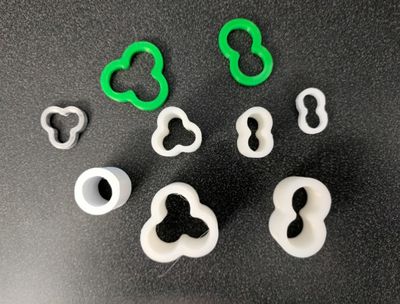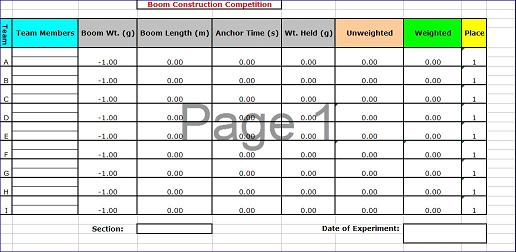Boom Construction Competition
Objectives
The experimental objective of this lab is to design and construct a boom, following the specifications provided. Your boom will be entered in a competition against the other students' booms in your section. You will learn how booms are used and what factors engineers consider when designing them.
Overview
A boom is used to help lift and move heavy objects; objects much heavier than the boom itself. The main problem in designing a boom is distributing the weight of the object (the load) being lifted over the length of the boom. The engineer must consider the maximum load the boom will be required to lift, how high the load will need to be lifted, and whether the boom will be moved around while loaded or not.
Examples of booms that you may not have thought of are certain types of bridges. A cantilever bridge is actually two booms extending from a common base. One type of a cantilever bridge is a cable-stayed bridge, with a concept of one shown in Figure 1.
The Queensboro Bridge is an example of a double cantilever bridge and is shown in Figure 2. If you look carefully at the figure, you'll see two bases, and the two booms extending from each base, with the cantilevers placed end to end.
The Grand Bridge over Newtown Creek is an example of a swing bridge, also known as a rotating bridge, and is shown in Figure 3. In this case, the bridge is two booms mounted on a base that rotates.
Finally, Figure 4 shows a bascule bridge, more commonly known as a drawbridge, where it's clear that the bridge is a big very flat boom.
Note that not all bridges are booms. For example, suspension bridges, where the deck is supported by steel cables, are not booms. Examples of suspension bridges are the Brooklyn Bridge, Manhattan Bridge, Verrazano-Narrows Bridge, and George Washington Bridge.
Cranes are the most common example of booms in action. The crane pictured in Figure 5 is a tower crane. These cranes are a fixture on construction sites across the country and around the world. A tower crane can lift a staggering 40,000-pound load of construction material and machinery. It is attached to the ground by anchor bolts driven through a 400,000-pound concrete pad poured a few weeks before the crane is erected.1
FYI:
- A Dead Load is a stationary load
- A Live Load is a moving or mobile load
- A Cyclic Load is a load that changes periodically
When you work on the design for your boom, you must take into account the properties of the materials you will use. To discuss the mechanical properties and deformation of solids, we must first understand stress and strain. When an external force is applied to a piece of material, it changes shape (e.g.,
changes length and cross section perpendicular to the length). Understanding how such deformations will affect materials is critical information for an engineer.
There are three basic types of stresses; tensile (pulling or stretching), compressive (squeezing or squashing) and shear (bending or cleaving). If a rod of material is put under tensile stress, its length increases slightly in the direction of the applied force and its cross-section perpendicular to the force decreases. If the rod is placed under compressive stress, its length in the direction of the force will decrease and its cross-section perpendicular to the force will increase. If the rod is placed under shear stress it will bend in the direction of the applied force and its length and cross-section will be distorted, see Figure 6.
According to Serway and Beichner in Physics for Scientists and Engineers,2 stress is the external force acting on an object per unit cross sectional area. Strain is the measure of deformation resulting from an applied stress.
The expression for tensile stress is:
where s is the stress, F is the applied force and A is the cross-sectional area of the object perpendicular to the force. The expression for the resulting strain e is:
where is the change in length and L0 is the object's original length.
Strain is proportional to stress for small values of strain, and the proportionality constant depends on the material being deformed and on the type of deformation. The proportionality constant is called an elastic modulus. The module for different materials vary considerably and the various moduli for a particular material may also vary significantly, e.g., concrete is very strong in compression but less so in tension; wood breaks quite easily when bent, and because of its natural grain it is anisotropic (properties depend on the direction in the material).
Figure 8 shows the effects of tensile stress on a typical rod of material. In the elastic region, the material will regain its original shape once the stress (or load) is removed. In the plastic region, the material loses its elasticity and is permanently deformed.
The elastic limit for a material is the maximum strain it can sustain before it becomes permanently deformed (i.e. if you decrease the stress, the object no longer relaxes back to its original size and shape). If you increase the stress past the elastic limit, the material will plastically deform and for sufficiently large stress ultimately fail. The ultimate tensile strength is the maximum amount of stress a material can undergo. The fracture stress is the point at which the material breaks under tension. Fracture stress is lower than the ultimate tensile strength because as strain increases, the material becomes thinner and thinner. As this necking down process continues, the amount of load that can be supported decreases and the material breaks.
In addition to these intrinsic materials factors, an engineer must consider the behavior of materials as they age and are used in service. These factors do not relate directly to the design of your "one-time-use" boom, but they need to be taken into consideration when deciding what material to use for an actual design. The loss of desirable properties through use, called fatigue, is often an important issue. Non-static loads, repeated loading and unloading, or loads that include vibrations, oscillations etc., may lead to failure in service. Special care must be taken with live loads and situations where small motions may be magnified by design features.
The first aging factor is chemical degradation and, in particular, corrosion. Light and chemicals present in the environment can cause chemical reactions with the materials chosen for a design. These reactions can cause a loss of strength, flexibility or other desirable material properties. Corrosion occurs when two or more materials or substances react with each other, in the presence of an electrolyte. For example, rust results when iron or simple steel is exposed to water, or just even humid air. Rust is particularly damaging because it flakes off, thinning and weakening the underlying material. Careful choice of material will minimize the effects of chemical degradation. However, the cost is often limiting factor and cheap countermeasures like paint and other coatings are often employed.
Erosion is another factor in material failure. It is weathering caused by exposure to environmental factors like wind driven dust or sand, rain or flowing water. The smoothing of rocks by a river or the sea is a good example of this kind of process. Care in the design process can help minimize the effect of erosion. Again the cost is often the limiting factor and coatings are often employed to protect an object.
A third factor in material failure is thermal cycling. Materials in an object will routinely warm up and cool down while in use (especially device that generates heat internally), over the course of a normal day, or even over a year. This thermal cycling is accompanied by physical expansion and contraction of the object. Different materials expand and contract by different amounts and this can lead to internal stress and strains, and ultimately failure. Careful choice and matching of materials can minimize the effects of thermal cycling, but the cost may limit the choices. Accumulations of water, which can freeze and thaw, can be very damaging and coatings are often especially vulnerable to thermal cycling as they may crack and peel off, exposing the underlying material in need of protection.
A related but more dramatic mode of failure is thermal shock. This can occur when objects made of certain materials are exposed to extreme temperature changes over a short period of time. If the material is inhomogeneous (i.e., properties not uniform throughout), thermal expansion or contraction can be sufficiently non-uniform to cause cracking. If the cracks spread far enough, the material will fail in spectacular fashion. Imagine quickly immersing a very cold ordinary glass bottle in very hot water. Often such failures can be avoided by heat treatment (annealing) and in general, material properties can be improved significantly through heat treatment and mechanical working. For example, the familiar PyrexTM glass is specially treated to avoid thermal shock.
There are many factors to consider in any design project. When designing and constructing your boom for this competition, remember to consider the materials you are using and what might cause those materials to fail under a load.
Competition Rules
The competition rules must be followed at all times during the competition. Violation of any of these rules will result in the disqualification of your team.
- Your boom must extend at least 1.5 meters horizontally from the front edge of the anchorage.
- You have 2 minutes to anchor your boom.
- Your boom may not touch anything but the anchorage.
- The basic unweighted ratio for the competition is:
- The winning design will be determined based on the following weighted design ratio:
Design Considerations
- Which aspects of the competition formula are most advantageous?
- How can the boom be built and/or reinforced to prevent as much deflection as possible?
Note: You and your partner are to design a boom. The boom is to be secured (i.e., anchored) to the white plastic anchorage provided at the front of the lab. The boom must extend at least 1.5 m from the front edge of the anchorage and deflect as little as possible when loaded.
Materials and Equipment
- 2 Thick Dowels (1.1cm x 122cm)
- 2 Thin Dowels (0.8cm x 122cm)
- 6 Bamboo Skewers (30.5cm)
- 3D Printed Dowel Connectors
- Cellophane Tape
- String
NOTE: A saw is available to cut the dowels. Ask your TA for assistance, as students are not allowed to use the saw.
Procedure
Boom Design and Construction
- Assess your materials and consider your design options, keeping in mind the competition specifications. Make sure you make preliminary sketches during this process.
- Now sketch your actual basic design in pencil using the graph paper sample provided on the EG website. Label your design clearly and have your TA sign and date it.
- Construct your boom based on the sketch you just completed and the available materials. Your TA will provide the materials allowed for your design. If you decide to modify your design during the construction phase of your boom, make sure to note the changes and describe your reasons for them.
- Your TA will weigh your boom and record the weight in the competition spreadsheet for your section.
Competition
Note: Attaching your boom to the anchorage is a critical phase of the competition. You will be timed. Making sure you have a plan before you start will help you anchor the boom quickly and improve your standing in the competition. You may want to practice before your trial begins. Remember you will be disqualified if anchoring your boom takes more than two minutes.
- When the TA says "go," attach your boom to the anchorage and shout "done" when your team is finished. The TA will give you your anchoring time. You will use this number to compute your boom's design ratio.
- Your TA will measure your boom and record the length in the competition spreadsheet for your section.
- Your TA will attach a basket to the end of your boom and add weights until the boom deflects (bends) 0.2 m. The load supported will be weighed on the lab scale and the weight recorded in the competition spreadsheet for your section. See Figure 9.
Your TA has prepared an Excel file with your section's results. Go to the Lab Documents section of the EG Website. This chart must be included in your PowerPoint presentation and in the data section of your lab report. Your lab work is now complete. Please clean up your workstation. Return all unused materials to your TA. Refer to section 3 of Your Assignment for the instructions you need to prepare your lab report.
Assignment
Optional BONUS Individual Lab Report
Follow the lab report guidelines laid out in the page called Specifications for Writing Your Lab Reports in the Technical Communication section of this manual. As you write, the following discussion points should be addressed in the appropriate section of your lab report:
- Describe the rules of the competition in your introduction. What consequences did the rules have for your design decisions? Use the appropriate equations in your answer.
- What factors did you consider in designing your boom? Did you use any of the background information?
- What was the weight ratio and design ratio for your design?
- What do you think would be the maximum design ratio for this project? Compare your results with this ideal ratio.
- What important design characteristics should a winning boom include to achieve the highest possible weighted ratio?
- Describe how the components you have chosen function in your design, and describe its overall height/length/shape/etc.
- Describe the advantages and disadvantages of your boom design.
- Discuss design improvements. How would you optimize the design (i.e. improve the ratio) based on experience?
- Which elements of the boom (e.g., wooden dowels, 3D printed dowel connectors, Kevlar string, etc.,) were stressed by the load, in what directions, and contributed to the failure?
- Include spreadsheet with every team's results. Describe the results and talk about other designs in the class.
Remember: Lab notes must be taken. Experimental details are easily forgotten unless written down. EG1004 Lab Notes Paper can be downloaded and printed from the EG1004 Website. Use the lab notes to write the Procedure section of the lab report. At the end of each lab, a TA will scan the lab notes and upload them to the Lab Documents section of the EG1004 Website. One point of extra credit is awarded if the lab notes are attached at the end of the lab report. Keeping careful notes is an essential component of all scientific practice.
Team PowerPoint Presentation
Follow the presentation guidelines laid out in the page called EG1003 Lab Presentation Format in the Introduction to Technical Presentations section of this manual. When you are preparing your presentation, consider the following points:
- How would you improve your boom design?
- Other than the examples given in this lab, what are other examples of booms?
- Which elements of the boom (e.g., wooden dowels, 3D printed dowel connectors, Kevlar string, etc.,) were stressed by the load, in what directions, and contributed to the failure?
Footnotes
1 How Stuff Works website. 2003. SHW Media Network. Retrieved July 28th, 2003. http://science.howstuffworks.com/tower-crane3.htm
2 Serway, R., Beichner, R., Physics for Scientists and Engineers with Modern Physics, 5th Edition. Fort Worth, TX: Saunders College Publishing, 2000
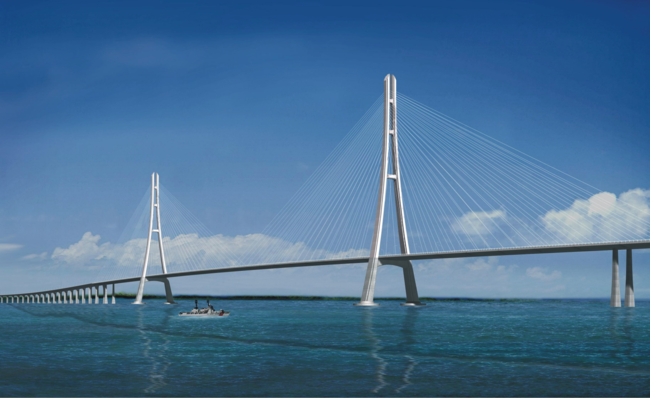




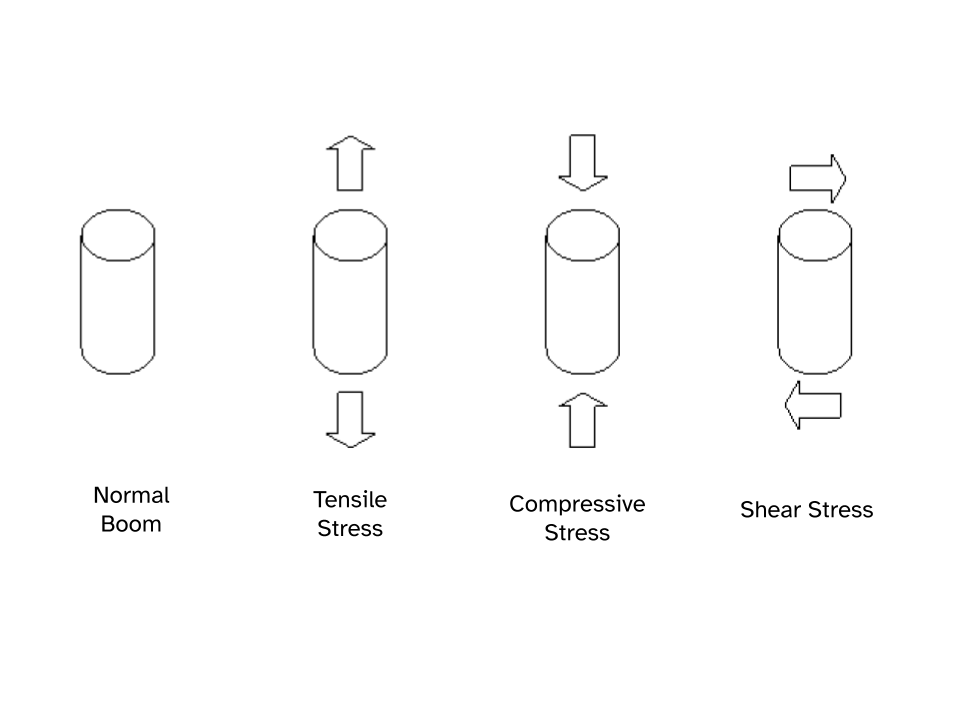
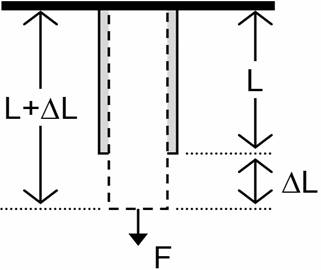


 is the change in length and L0 is
the object's original length.
is the change in length and L0 is
the object's original length.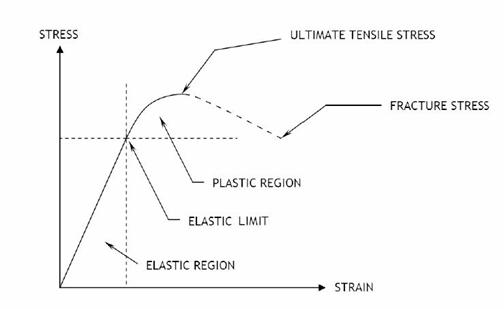

![{\displaystyle Weighted\ Ratio={\frac {Weight\ Supported}{Boom\ Weight}}\times {\frac {60\left[{\text{s}}\right]}{Anchor\ Time\left[{\text{s}}\right]+30\left[{\text{s}}\right]}}\times {\frac {Boom\ Length\left[{\text{m}}\right]}{1.5\left[{\text{m}}\right]}}\,}](https://wikimedia.org/api/rest_v1/media/math/render/png/ef499d8299ec68671723a6b97a38af579aab5e64)
